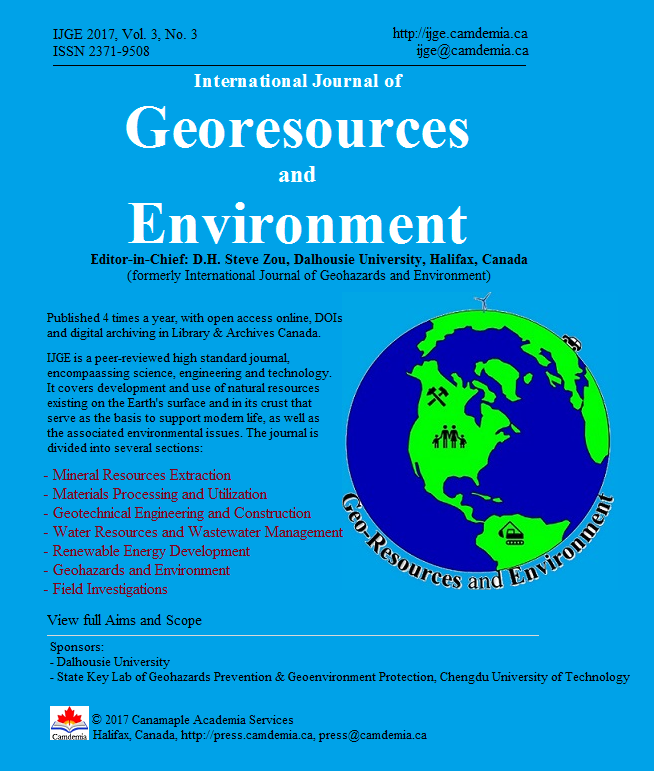Geophysical Monitoring of Underground Constructions and its Theoretical Basis
DOI:
https://doi.org/10.15273/ijge.2017.03.007Keywords:
monitoring, P- and S-wave velocity, stress state, tunnels, underground hallsAbstract
To avoid damage of rock mass, their collapse into underground space, danger for equipment and risks for human life, during construction and exploitation of large engineering projects (e.g. underground spaces, tunnels, machine halls, etc.) in-situ geotechnical and geophysical monitoring is carried out. Geophysical monitoring is based on observations of the elastic shear – and longitudinal wave velocities (Vs and Vp, respectively) and Acoustic Emission (AE). The behaviors of the elastic velocities and parameters of AE during rock deformation depend on the types of the future failure that, in turn, are defined by the structure and properties of the medium and characteristics of stress state s3/s1 and hydrostatic pressure. These velocity variations are defined by difference in effective parameters of forming microfractures, whose geometry is distinguished at different modes of stress state. At that character of interaction between microfractures determines the types of the macrofailure. In this study, we discuss the behaviors of longitudinal wave velocities and acoustic emission during loading of large rock blocks and underground opening orienting measurements along maximum (s1) and minimum (s3) stresses. It is shown that velocity variations along the maximum stress is more informative at elastic phase of rock deformations (velocity increases), whereas velocity variations along axis of the minimum stress is more informative at the stage of nonlinear rock deformation (velocity begins to decrease during microfractures occurrence). These regularities are well observed at unloading rock mass in the Zhinvali tailrace tunnel where geophysical monitoring assisted in the construction. This knowledge could be used in planning and monitoring the stability of underground structures.Downloads
Published
Issue
Section
License
Copyright, Terms and Conditions
The International Journal of Geohazards and Environment (the Journal) is published by Canamaple Academia Services (the Publisher) online with open access, under a Creative Commons Attribution-Noncommercial license (CC-BY-NC) (http://creativecommons.org/licenses/by-nc/4.0/). Authors (the Authors) submitting papers (the Work) for publication in the Journal automatically agree to the following terms and conditions.
1. Under the license (CC-BY-NC), Authors give permission for others to share and reuse the Work, as long as the original source and author(s) are properly cited (i.e. a complete bibliographic citation and link to the Journal website) and the material is not used for commercial purposes. Any sharing or reuse must however indicate the original CC-BY-NC license terms of the work.
2. Authors transfer and assign to the Publisher all copyright in and to the Work. However Authors retain all proprietary rights except the copyright, related to the Work and also retain the rights a) to use, reproduce, distribute, and publicly display the Work in any medium in connection with the Authors‘ academic and professional activities, such as teaching, presentations and lectures, b) to create derivative works from the Work and to make full use of the Work in future research and publications, c) to authorize others to make any non-commercial use of the Work, d) to make both the pre-published and final-published versions available online in institutional and/or disciplinary repositories or on their own websites with a citation and link to the original paper published in the Journal.
3. Authors warrant that the Work is their original work, it is not copied from anywhere or anyone else, they are totally responsible for the authenticity, originality, validity and accuracy, and the facts and views are their own, that the Work contains no matter which is defamatory or infringes any literary or proprietary rights, intellectual property rights, or any rights of privacy, and that the Work has not been simultaneously submitted to any other journals or publishers. Authors further agree that their manuscripts whether accepted or rejected will not be returned and the rejected manuscripts will be disposed at the journal editor's discretion.
Disclaimer: The Publisher, the Journal and the editors accept no responsibility for statements or opinions expressed by authors. Use of information and materials in the Journal is the sole responsibility of users.


